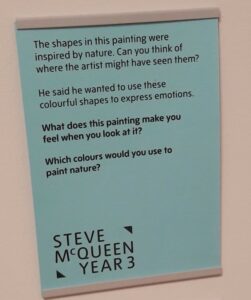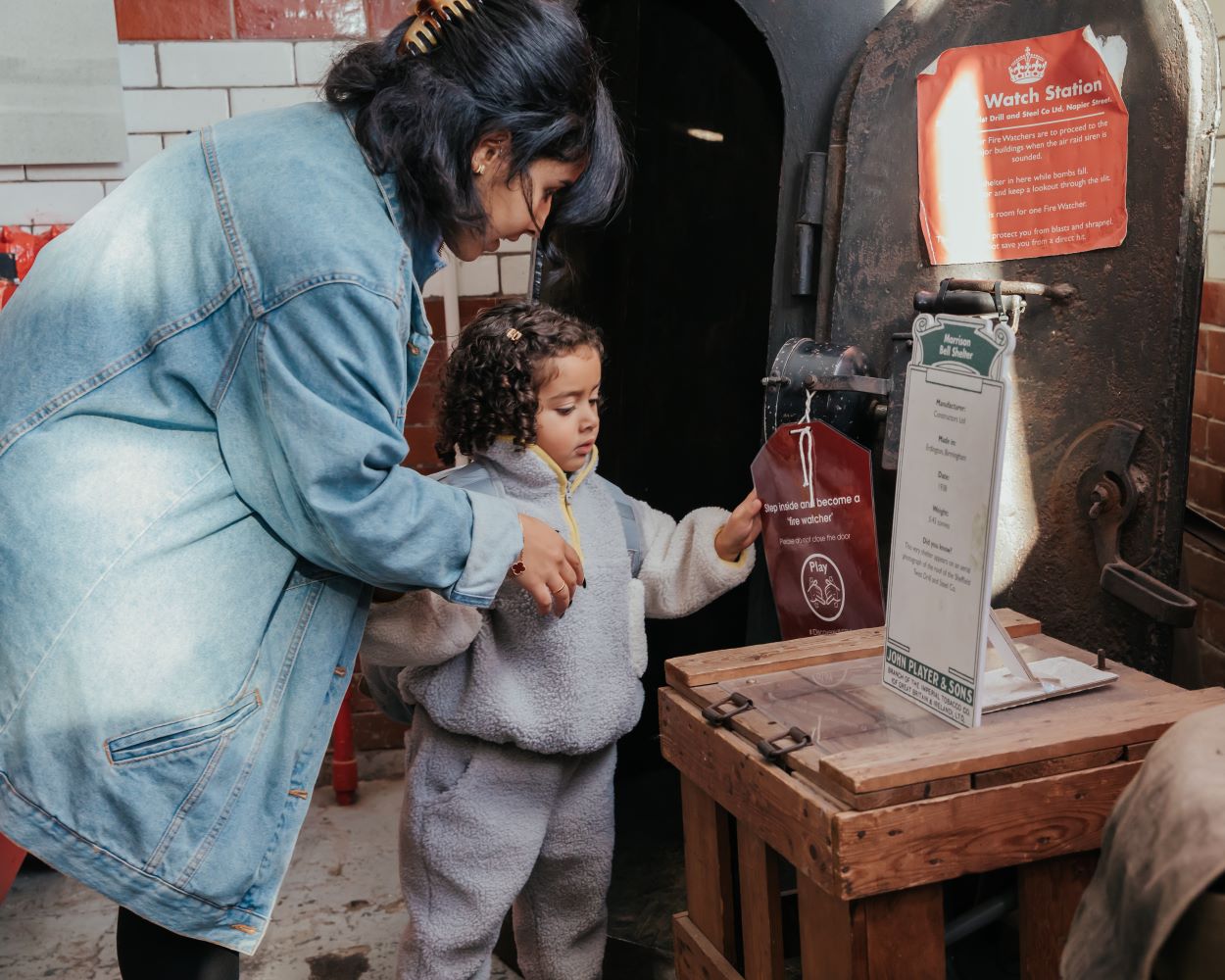This guide was created in partnership with Sarah Shaw, Director of Museum Tales Ltd. Sarah has produced family friendly interpretation for English Heritage, York Art Gallery, Bath Abbey and other venues across the UK.
Kids in Museums believes that welcoming families to your venue is essential for any museum, but this can be a daunting prospect for staff and volunteers. We’ve created this short guide to support you and your team to develop a more welcoming environment for families by introducing family friendly interpretation.
Please note this resource does not cover digital interpretation or resources.
Getting started
Creating family friendly text for your exhibition needn’t be difficult, it just needs some planning and thought. Whether you’re producing an exhibition aimed at families, or want to enhance your wider interpretation to engage families – you need to plan to be accessible to all ages.

One of the key things to think about is who your exhibition is aimed at. If it’s a family friendly exhibition, such as the British Library’s Marvellous and Mischievous: Literature’s Young Rebels, you’ll want to aim your text, design and approach at the whole family, with nods to particular age groups.
However, if families are just a small part of your demographic, you might want to plan a way to share top items, point out key facts and stimulate conversation. You’ll notice that places like Tate create discrete, specific family labels made to complement the wider adult audience text. Other venues make use of mascots to highlight family friendly information.
Remember though, that families can be short on time and attention spans, so don’t overload them with interpretation. What they want is easy to read, layered interpretation which is complimented by a great family friendly welcome (more advice on this in our Welcoming families to your venue resource), knowledgeable staff and volunteers, and child friendly resources if you have them (more advice on this in our Creating Self-Guided Resources for Families guide.)
Whichever one you choose, it’s essential that you plan for families and think about how you might want to engage with them through your interpretation in the future.
Knowing your audience
It’s important with an exhibition or panel to remember that families come in all shapes and sizes. They have different dynamics, knowledge, points of reference and drivers for coming to your venue.
Before you start writing your text – whether that be for a panel or a whole exhibition – it’s worth narrowing down who your text is for.
You can find out more about your visitors by conducting quick surveys at the entrance desk, running focus groups or looking into audience analysis. Perhaps your organisation is part of Audience Answers, or has worked with a market research company. Ask around and then define who your text is for.
Creating a checklist
Once you’ve identified your audience, it’s useful to create a checklist of your aspirations for your text and how it will meet the needs of your families. This can cover everything from your tone of voice to keeping track of reading ages and getting the narrative of your exhibition across.
This could look like:
- Is the text aimed at the age of children and family demographic that we’re hoping for?
Look at our guide to Creating Self-Guided Family Resources for more information on different age groups. - Is this text within the word count we’ve allowed?
Families need to be able to find information quickly. Set a word count for each type of text (e.g., whole panel, fact boxes, playful prompts, family labels). This might be 100 words for a panel aimed solely at families and 30 words for a fact box for families. - Does this text represent the voice we want our families to hear?
Set yourself a challenge to create a voice for families in your text. Do you want your family text to be playful, authoritative or exploratory? Will you use an active or passive voice? Look at this playful prompt from Market Hall Museum in Warwick. - Does my text meet the needs of the average reading age in the UK?
The average reading age in the UK for an adult is between the ages of 9 and 11. Make sure that you’re sticking to this by using apps such as Grammarly, British Dyslexia Association and Hemingway Editor, which tests for complex terms and sentences. - Does this do what we set out to do?
Consider the aims of your text and if your content meets it. Is the aim to share knowledge, set a tone, prompt discussion or something else?
Leeds Museum and Galleries has a fantastic practical guide to writing text interpretation that covers many of these points.
It’s easy to get carried away when you’re passionate about a subject, so use your checklist to ensure that you’re on the right track. We recommend working with your wider team to create this to ensure buy in from the whole exhibition team.
What might family interpretation look like?
There are many organisations out there producing a wide variety of exhibitions and interpretation for families. From English Heritage’s award winning family friendly exhibition at Birdoswald Roman Fort to the use of mascots and family friendly labels at Cranwell Aviation Heritage Museum.
If you’re wanting to go the whole hog and produce panel text aimed at families, remember these golden rules:
- Producing family friendly text isn’t dumbing down, it’s about making themes, information and stories engaging, readable and appealing.
- Don’t assume knowledge and think if technical terms need to be used. If they are used, explain them in brackets.
- Try and avoid fixed routes for reading panels – children often don’t follow the linear route you’ve envisaged.
- Don’t shy away from sensitive or challenging topics. Our Kids in Museums guide to engaging children, young people and families with sensitive topics can offer support with this.
- We recommend stimulating dialogue, encouraging exploration and using active language. ‘What do you think? Can you imagine? Have you ever seen one of these before?’’
- Think about what content will appeal to families – horrible histories, fun facts, real life stories, myths, legends and animals are all good starting points.
Illustrations are a great way to share more stories about your work, and are super visual prompts for families. If you’re doing the same, pick an illustration style that won’t date and ensure that when depicting people, that diverse imagery is reflected. Westminster Abbey has great examples of this across its family programme and interpretation, as seen on the Families web page.
Keeping family interpretation accessible
Bright colours and illustrations are fantastic and can really appeal to families, but remember to keep access principles in mind to ensure that your text is legible and meets best practice recommendations. Read Exhibitions for All, a practical guide to designing inclusive exhibitions from National Museums Scotland.
Think about the height of your labels – can children see them, including those in wheelchairs? Colour contrast is key for accessibility, as is lighting to ensure that labels are easy to read.
Don’t forget to produce your family resources in accessible formats too, such as large print guides, Braille, BSL and captioned videos. Many venues now try to utilise other sign languages such as Makaton. In this Instagram post, we share some examples from Wakefield Museums, who have installed Makaton elements throughout their venues.
Test, Test, Test
Finally, when you’re producing any text or resources for families, don’t forget to write with them, not for them. Perhaps you can set up a focus group to test out your ideas, or ask local families to comment on your panels to ensure that they’re fit for purpose. Have a look at the SEND in Museums Working With Not For Families: A Quick Guide To Consulting With Families resource for more information on this.
Further reading/ Useful resources
The great news is, there are loads of places to go for help when it comes to producing family friendly interpretation. Here’s a quick reading list to keep you going:
- Association for Heritage Interpretation
- The Children’s Country House at Sudbury
The National Trust’s landmark site is testing out new family friendly interpretation all the time. - Human Centred Design Handbook – Derby Museums
- Interpretation guidance – National Lottery Heritage Fund
The NLHF has produced a fantastic tool featuring clear information on producing accessible interpretation. - Evaluation Toolkit for Museum Practitioners – SHARE Museums East
This toolkit is useful for developing consultation techniques.
Further information on reading levels
The Kids in Museums website is packed with advice, case studies and training related to producing family friendly interpretation. This includes:
- How can your museum support children and young people to respond to the climate and ecological emergency?
- How can your museum work alongside children, young people and families to develop anti-racist practice?
- How can your museum engage with children, young people and families with LGBTQ+ heritage?
Files for this Resource
Tags: Welsh Language
Categories: Creating family events and resources
Audience: Family

